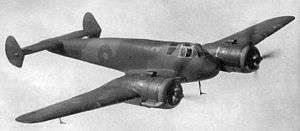Gloster F.9/37
| Gloster F.9/37 | |
|---|---|
 | |
| Gloster F.9/37 | |
| Role | Fighter |
| Manufacturer | Gloster Aircraft Company |
| Designer | George Carter |
| First flight | 3 April 1939 |
| Primary user | Royal Air Force (intended) |
| Number built | 2 |
|
| |
The Gloster F.9/37, also known as the Gloster G.39, was a British twin-engined design from the Gloster Aircraft Company for a cannon-armed fighter to serve with the Royal Air Force, planned before the Second World War. The F.9/37 was rejected in favour of other designs.
A development of the F.9/37 as a night fighter, for a new Air Ministry Specifications F.29/40 – known unofficially as the "Gloster Reaper" – was dropped so that Gloster would be able to concentrate on existing work and on the nascent British jet projects.
Design and development
Gloster had designed a twin-engined turret-fighter for specification F.34/35 but the single-engine design from Boulton Paul (Boulton Paul Defiant) for F.9/35 was seen to cover both requirements and the F.34/55 design dropped. Less than two years later, F.9/37 for a "twin-engined single-seat fighter with fixed armament" was issued.[1]
The F.9/37 was designed under the direction of W. G. Carter, his first for Gloster, to F.9/37 (hence the name) as a single-seat fighter carrying an armament of four 0.303 in (7.7 mm) Browning machine guns and two 20 mm Hispano cannon in the nose. Intended for dispersed production by semi-skilled labour the structure broke down into sub-assemblies.[2]
A prototype (military serial number L7999) with 1,060 hp Bristol Taurus T-S(a) radial engines flew on 3 April 1939,[3] and demonstrated excellent performance, its maximum speed of 360 mph (580 km/h) being the best recorded by a British fighter at the time.[3] Test flights revealed that the prototype was very manoeuvrable and "a delight to fly."[4] However, after being badly damaged in a landing accident in July 1939, it was re-engined with 900 hp Taurus T-S(a)-IIIs in 1940, which resulted in reduced performance. A second prototype (L8002) with 880 hp Rolls-Royce Peregrine I liquid-cooled inline engines flew on 22 February 1940,[3] it proved capable of 330 mph (530 km/h) at 15,000 ft (4,570 m).[5]
F.18/40 and F.29/40
Specification F.18/40, for a dedicated night fighter, with both nose- and turret-mounted guns, led to Gloster submitting a design based on the F.9/37, fitted with Rolls-Royce Merlin engines, a dorsal four-gun turret and Airborne Interception (AI) radar.[6] This received support from the Air Staff who saw it as superior to the Bristol Beaufighter and the Air Ministry ordered one of the F.9/37 prototypes to be converted to the new specification as F.29/40.[7]
Unofficially known as the "Gloster Reaper", it inherited the admirable handling characteristics of the F.9/37, and despite being judged superior to other designs, including turreted variants of the Beaufighter and de Havilland Mosquito, the Reaper was terminated[7] in May 1941, so that Gloster could concentrate on other work, especially its work on jet aircraft.
Specifications (L7999 with Taurus engine)
Data from The British Fighter since 1912[3]Gloster Aircraft since 1917[8]
General characteristics
- Crew: one
- Length: 37 ft ½ in (11.29 m)
- Wingspan: 50 ft ½ in (15.26 m)
- Height: 11 ft 7 in (3.53 m)
- Wing area: 386 ft² (35.9 m²)
- Empty weight: 8,828 lb (4,013 kg)
- Loaded weight: 11,615 lb (5,280 kg)
- Powerplant: 2 × Bristol Taurus T-S(a) 14 cylinder radial engine, 1,000 hp (746 kW) each
- Propellers: 3-bladed metal Rotol variable pitch [8] propeller, 1 per engine
- Propeller diameter: 10 ft (3.04 m)
Performance
- Maximum speed: 360 mph (313 knots, 580 km/h) at 15,000 ft (4,570 m)
- Service ceiling: 30,000 ft (9,150 m)
- Rate of climb: 2,460 ft/min[9] (12.5 m/s) at 15,000 ft
- Wing loading: 30.1 lb/ft² (147 kg/m²)
- Power/mass: 0.172 lb/hp (0.283 kW/kg)
- Climb to 28,000 feet (8,500 m): 19 min, 36 sec
Armament
- Guns:
- Four 0.303 in (7.7 mm) Browning machine guns
- Two 20 mm Hispano cannon
- Bombs: provision for 20lb bomb carriers[8]
See also
- Aircraft of comparable role, configuration and era
- Bristol Beaufighter
- de Havilland Mosquito
- Focke-Wulf Fw 187
- Fokker G.1
- Grumman XP-50
- Messerschmitt Bf 110
- Westland Whirlwind
- Related lists
References
Notes
- ↑ King, H. F. "From Mars to Javelin: F.9/37 (Taurus engines)." Flight, 27 May 1955, p. 275.
- ↑ Mondey, David (1982). Hamlyn Concise Guide to British Aircraft of World War II. Chancellor Press. p. 117. ISBN 1851526684.
- 1 2 3 4 Mason 1992, p. 279.
- ↑ Green 1961, p. 51.
- ↑ James 1987, p. 236.
- ↑ Morgan 1992, p. 360.
- 1 2 Buttler 2004, p. 62.
- 1 2 3 James 1987, pp. 233–234.
- ↑ Green and Swanborough 1994
Bibliography
- Bowyer, Michael J.F. Interceptor Fighters for the Royal Air Force 1935-45. Wellingborough, UK: Patrick Stephens Ltd., 1984. ISBN 0-85059-726-9.
- Buttler, Tony. Secret Projects: British Fighters and Bombers 1935 -1950 (British Secret Projects 3). Leicester, UK: Midland Publishing, 2004. ISBN 1-85780-179-2.
- Green, William. War Planes of the Second World War, Volume Two: Fighters. London: MacDonald & Co. (Publishers), 1961.
- Green, William and Gordon Swanborough. The Complete Book of Fighters. New York: Smithmark, 1994. ISBN 0-8317-3939-8.
- James, Derek N. Gloster Aircraft since 1917. London: Putnam, 1987, First edition 1971. ISBN 0-85177-807-0.
- Mason, Francis K. The British Fighter Since 1912. Annapolis, Maryland: Naval Institute Press, 1992. ISBN 1-55750-082-7.
- Mondey, David. The Hamlyn Concise Guide to British Aircraft of World War II. London: Chancellor Press, 1994. ISBN 1-85152-668-4.
- Morgan, Eric B. "The Gloster F.9/37" Twentyfirst Profile Volume 1, No. 12, March 1992. New Milton, Hampshire, UK: 21st Profile Ltd., 1992.
External links
| Wikimedia Commons has media related to Gloster F.9/37. |